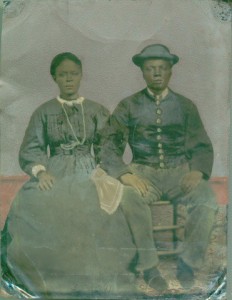Watch the Mercy Street series conclusion online at video.wnpt.org through March 6. Inside Mercy Street, a behind-the-scenes feature about the series, airs 6:30 p.m. Saturday, March 12.

By Rob DeHart
Tennessee State Museum
A recurring theme in Mercy Street is the possibility of freedom embraced by African-Americans during the Civil War. As the story progresses, Samuel, Aurelia and others take actions to decide their own fates. Throughout the South, enslaved people recognized that the war was crippling the institution of slavery, which led them to challenge the authority of their masters in many different ways. In Tennessee, more than 20,000 African-American men claimed their new status as freedmen by joining the Union Army.
 One of these soldiers was Adam Watkins. Watkins was born in Tennessee around 1843 and though records are unclear, he was likely enslaved northwest of Nashville in Montgomery or Robertson county. Slaves were not permitted to marry legally, but Adam had a lifelong relationship with an enslaved woman named Hannah. They had two children, John and Julia, by the time the Union Army occupied Middle Tennessee in 1862.
One of these soldiers was Adam Watkins. Watkins was born in Tennessee around 1843 and though records are unclear, he was likely enslaved northwest of Nashville in Montgomery or Robertson county. Slaves were not permitted to marry legally, but Adam had a lifelong relationship with an enslaved woman named Hannah. They had two children, John and Julia, by the time the Union Army occupied Middle Tennessee in 1862.
Many African-Americans responded to military occupation by escaping to areas controlled by the Union Army where they were often set to work constructing fortifications or, as shown in Mercy Street, working in hospitals. Allowing these former slaves to join the war effort and sometimes take up arms was considered controversial by many in the U.S. government and the Union Army. However, the calls of Frederick Douglass and other advocates, as well as the need for more soldiers in order to defeat the Confederacy, led to the creation of segregated units.
Adam Watkins enlisted in the Union Army on December 7, 1863, in Clarksville and was assigned to the 16th United States Colored Troop Infantry Regiment. He spent most of his service guarding strategic points around Chattanooga until December 1864 when the 16th participated in the Battle of Nashville. Following the battle, Watkins and his regiment pursued the defeated Confederate Army of Tennessee southward. Only two years earlier virtually every aspect of Watkins’ life was controlled by a slaveholder; now he was contributing to the surrender of the government that supported his former bondage.
Watkins mustered out of the army on April 30, 1866. Now that their marriage could be legally recognized, he and Hannah obtained a marriage license and in 1869 moved to Pulaski County in Illinois where they joined a community of other former slaves. The couple went on to have seven more children.
It would take another hundred years and overcoming many obstacles for his descendants to realize the full benefits of citizenship, but Adam Watkins laid the foundation by demonstrating that newly freed African Americans could contribute to the defense of the United States.
Rob DeHart is a curator at the Tennessee State Museum in Nashville where he specializes in technology and cultural history. DeHart received his M.A. in public history from Middle Tennessee State University and is a peer reviewer for the American Alliance of Museums.